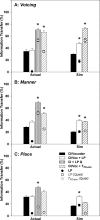The relative phonetic contributions of a cochlear implant and residual acoustic hearing to bimodal speech perception
- PMID: 22280613
- PMCID: PMC3283905
- DOI: 10.1121/1.3662074
The relative phonetic contributions of a cochlear implant and residual acoustic hearing to bimodal speech perception
Abstract
The addition of low-passed (LP) speech or even a tone following the fundamental frequency (F0) of speech has been shown to benefit speech recognition for cochlear implant (CI) users with residual acoustic hearing. The mechanisms underlying this benefit are still unclear. In this study, eight bimodal subjects (CI users with acoustic hearing in the non-implanted ear) and eight simulated bimodal subjects (using vocoded and LP speech) were tested on vowel and consonant recognition to determine the relative contributions of acoustic and phonetic cues, including F0, to the bimodal benefit. Several listening conditions were tested (CI/Vocoder, LP, T(F0-env), CI/Vocoder + LP, CI/Vocoder + T(F0-env)). Compared with CI/Vocoder performance, LP significantly enhanced both consonant and vowel perception, whereas a tone following the F0 contour of target speech and modulated with an amplitude envelope of the maximum frequency of the F0 contour (T(F0-env)) enhanced only consonant perception. Information transfer analysis revealed a dual mechanism in the bimodal benefit: The tone representing F0 provided voicing and manner information, whereas LP provided additional manner, place, and vowel formant information. The data in actual bimodal subjects also showed that the degree of the bimodal benefit depended on the cutoff and slope of residual acoustic hearing.
© 2012 Acoustical Society of America.
Figures






Similar articles
-
Beneficial acoustic speech cues for cochlear implant users with residual acoustic hearing.J Acoust Soc Am. 2012 May;131(5):4042-50. doi: 10.1121/1.3699191. J Acoust Soc Am. 2012. PMID: 22559377
-
Trimodal speech perception: how residual acoustic hearing supplements cochlear-implant consonant recognition in the presence of visual cues.Ear Hear. 2015 May-Jun;36(3):e99-112. doi: 10.1097/AUD.0000000000000131. Ear Hear. 2015. PMID: 25514796
-
Mandarin speech perception in combined electric and acoustic stimulation.PLoS One. 2014 Nov 11;9(11):e112471. doi: 10.1371/journal.pone.0112471. eCollection 2014. PLoS One. 2014. PMID: 25386962 Free PMC article.
-
An overview of factors affecting bimodal and electric-acoustic stimulation (EAS) speech understanding outcomes.Hear Res. 2023 Apr;431:108736. doi: 10.1016/j.heares.2023.108736. Epub 2023 Mar 5. Hear Res. 2023. PMID: 36931019 Review.
-
Combined acoustic and electric hearing: preserving residual acoustic hearing.Hear Res. 2008 Aug;242(1-2):164-71. doi: 10.1016/j.heares.2007.11.008. Epub 2007 Nov 29. Hear Res. 2008. PMID: 18164883 Free PMC article. Review.
Cited by
-
Interactions Between Slopes of Residual Hearing and Frequency Maps in Simulated Bimodal and Electric-Acoustic Stimulation Hearing.J Speech Lang Hear Res. 2024 Jan 8;67(1):282-295. doi: 10.1044/2023_JSLHR-22-00629. Epub 2023 Dec 13. J Speech Lang Hear Res. 2024. PMID: 38092067 Free PMC article.
-
Factors Affecting Bimodal Benefit in Pediatric Mandarin-Speaking Chinese Cochlear Implant Users.Ear Hear. 2019 Nov/Dec;40(6):1316-1327. doi: 10.1097/AUD.0000000000000712. Ear Hear. 2019. PMID: 30882534 Free PMC article.
-
Integration of acoustic and electric hearing is better in the same ear than across ears.Sci Rep. 2017 Oct 2;7(1):12500. doi: 10.1038/s41598-017-12298-3. Sci Rep. 2017. PMID: 28970567 Free PMC article.
-
A Within-Subject Comparison of Bimodal Hearing, Bilateral Cochlear Implantation, and Bilateral Cochlear Implantation With Bilateral Hearing Preservation: High-Performing Patients.Otol Neurotol. 2015 Sep;36(8):1331-7. doi: 10.1097/MAO.0000000000000804. Otol Neurotol. 2015. PMID: 26164443 Free PMC article.
-
Integration of fundamental frequency and voice-onset-time to voicing categorization: Listeners with normal hearing and bimodal hearing configurations.J Acoust Soc Am. 2023 Mar;153(3):1580. doi: 10.1121/10.0017429. J Acoust Soc Am. 2023. PMID: 37002096 Free PMC article.
References
-
- Armstrong, M., Pegg, P., James, C., and Blamey, P. (1997). “Speech perception in noise with implant and hearing aid,” Am. J. Otolaryngol. 18(6, Suppl.), S140–S141. - PubMed
Publication types
MeSH terms
Grants and funding
LinkOut - more resources
Full Text Sources
Medical

